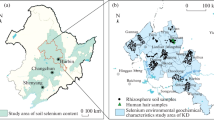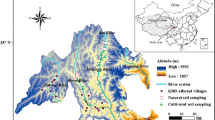Abstract
Now, there is a decreasing trend for the prevalence rate of Kaschin–Beck disease (KBD) in most parts of China, but the disease is still active and severe in the Tibetan Plateau for some reason. To further explore the role of selenium in the occurrence of KBD, We collected samples including drinking water, cultivated topsoil, Highland Barley grains, and tsamba in Rangtang County and Aba County, Sichuan Province and determined concentrations of selenium by Hydride Generation Atomic Fluorescence Spectrometry. Levels of selenium in the environment were analyzed in detail. Selenium in the soil–plant–food system and their relationship with prevalence rate of KBD were also discussed. The results indicate: (a) the levels of environmental selenium are very low and the study area belongs to a selenium-deficient ecological landscape; (b) the KBD becomes much more severe with decreasing environmental selenium under the selenium-deficient condition. Namely, the lower the environmental selenium is, the more severe the disease is; (c) soil selenium deficiency plays a critical role for the prevalence of local KBD, and more factors inducing selenium deficiency should be more concerned in the future.





Similar content being viewed by others
References
Chasseur, C., Suetens, C., Michel, V., et al. (2001). A 4-year study of the mycological aspects of Kaschin-Beck disease in Tibet. International Orthopaedics, 25, 154–158.
Chasseur, C., Suetens, C., Nolard, N., et al. (1997). Fungal contamination in barley and Kaschin-Beck disease in Tibet. The Lancet, 35, 1074.
Fang, H. C. (1988). The relationship of Kaschin-Beck and Keshan Diseases with hydrogeochemistry. Environmental Geology and Water Sciences, 12(1), 23–28.
Gromer, S., Eubel, J., Lee, B., et al. (2005). Human selenoproteins at a glance. Cellular and Molecular Life Sciences, 62(21), 2414–2437.
Holben, D., & Smith, A. (1999). The diverse role of selenium within selenoproteios: A review. Journal of the American Dietetic Association, 99(7), 836–843.
Hou, S. F., Wang, W. Y., Li, Y. T., et al. (1999). A study on dependence of natural regression of selenium responsive diseases areas upon selenium nutrition level. Endemic Diseases Bulletin, 14(3), 29–34. (in Chinese with English abstract).
Institute of Medicine, Food, Nutrition Board. (2000). Dietary reference intakes: Vitamin C, vitamin E, selenium, and carotenoids. Washington, DC: National Academy Press.
La, G. M., Mathieu, F., Begaux, F., et al. (2001). Kaschin-Beck disease and drinking water in central Tibet. International Orthopaedics, 25, 167–169.
Li, S. J., Li, W., Hu, X., et al. (2009). Soil selenium concentration and Kaschin-Beck disease prevalence in Tibet, China. Frontiers of Environmental Science & Engineering in China, 3(1), 62–68.
Li, S. J., Yang, L. S., Wang, W. Y., et al. (2007). Relationship between selenium concentration in child hair and the distribution of Kashin-Beck disease in Tibet, China. Frontiers of Medicine in China, 1(2), 223–225.
Ministry of Health of the People’s Republic of China. (1995). Diagnostic criteria of Kaschin-Beck disease (GB16003-1995). http://www.moh.gov.cn/publicfiles/business/htmlfiles/zwgkzt/pwsbz/index.htm. Accessed 15 Sept 2010.
National Kaschin-Beck Disease Surveillance Group. (2007). Report of a national survey of Kaschin-Beck disease prevalence in 2006. Chinese Journal of Endemiology, 26(6), 646–648. (in Chinese with English abstract).
Peng, A., & Yang, C. L. (1991). Examination of the roles of selenium in the Kaschin-Beck disease. Biological Trace Element Research, 28(1), 1–9.
Suetens, C., Reyes, R. M., Chasseur, C., et al. (2001). Epidemiological support for a multifactorial aetiology of Kashin-Beck disease in Tibet. International Orthopaedics, 25, 180–187.
Tan, J. A. (1989). The Atlas of Endemic diseases and their environment in the People’s Republic of China. Beijing (in Chinese): Science Press.
Tan, J. A., Wang, W. Y., Zhu, Z. Y., et al. (1988). Selenium in environment and Kaschin-Beck disease. Chinese Journal of Geochemistry, 7(3), 273–280.
Tan, J. A., Zhu, W. Y., Wang, W. Y., et al. (2002). Selenium in soil and endemic diseases in China. The Science of the Total Environment, 28(4), 227–235.
Xu, L. Q., Sen, W. X., Xiong, Q. H., et al. (1991). Selenium in Kashin-Beck disease areas. Biological Trace Element Research, 31, 1–9.
Yang, X. E., Chen, W. R., & Feng, Y. (2007). Improving human micronutrient nutrition through biofortification in the soil-plant system: China as a case study. Environmental Geochemistry and Health, 29(5), 413–428.
Zamana, L. V. (1995). Possible hydrogeochemical preconditions for Kaschin-Beck disease in Transbaikalia. Chinese Geographical Science, 5(2), 185–192.
Zhang, X. P., & Zhang, Y. X. (2000). Content and distribution of selenium in soils of Tibet. Acta Pedologica Sinica, 37(4), 558–562. (In Chinese with English abstract).
Zou, K., Liu, G., Wu, T., et al. (2009). Selenium for preventing Kaschin-Beck osteoarthropathy in children: a meta-analysis. Osteoarthritis and Cartilage, 17, 144–151.
Acknowledgments
We gratefully acknowledge funding from the National Natural Science Foundation of China (No. 40671008) and the National 11th Five-Year Plan scientific and technological issues (No. 2007BAI25B01). We also thank the local government of Rangtang County and Aba County, Sichuan Province for their help during the field investigations which are carried out in early September 2007 and June 2009. Finally, special thanks are due to all the reviewers for improvement of the manuscript.
Author information
Authors and Affiliations
Corresponding author
Additional information
An erratum to this article can be found at http://dx.doi.org/10.1007/s10653-011-9446-7.
Rights and permissions
About this article
Cite this article
Zhang, B., Yang, L., Wang, W. et al. Environmental selenium in the Kaschin–Beck disease area, Tibetan Plateau, China. Environ Geochem Health 33, 495–501 (2011). https://doi.org/10.1007/s10653-010-9366-y
Received:
Accepted:
Published:
Issue Date:
DOI: https://doi.org/10.1007/s10653-010-9366-y




